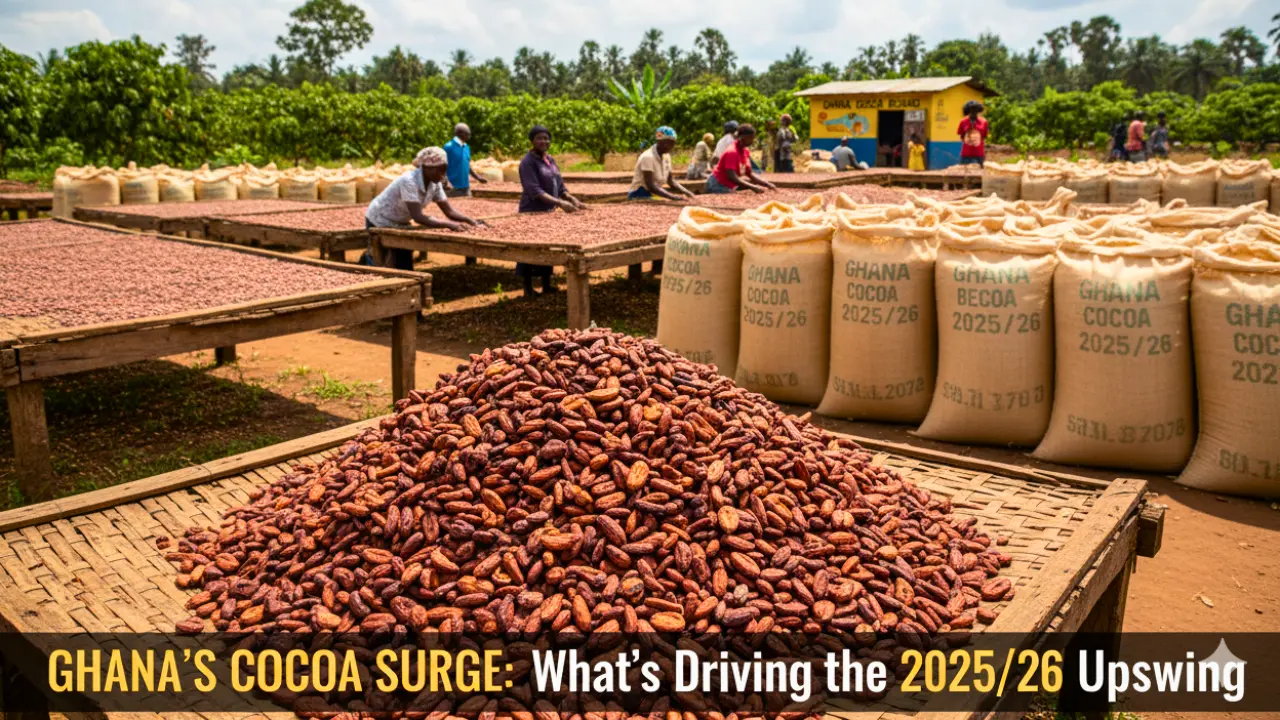Ghana Cocoa Surge Output: Ghana’s cocoa sector is showing signs of a strong resurgence. According to Agriculture Minister Eric Opoku, the country expects cocoa production in the 2025/26 season to exceed 650,000 metric tons, surpassing earlier benchmarks set for the year.
Context: Why this matters
Ghana, along with its neighbour Côte d’Ivoire, together account for roughly 60% of global cocoa bean supply. Disruptions, declines or surges in their output tend to ripple across commodity markets, chocolate manufacturers and global trade flows.
In recent years, Ghana suffered a slump—output for 2023/24 was at its lowest in decades owing to disease, smuggling and illegal mining. The rebound signals a potential turning point.
Key Drivers of the Upturn
Improved yields & weather
Minister Opoku attributed the positive outlook to better‑than‑expected flowering and pod development, with weather conditions cooperating and disease spread being better managed.
Higher farm‑gate price and farmer incentives
Ghana raised the price paid to cocoa farmers to about US$ 4,640 per ton for the season, which helped reduce smuggling and improve formal procurement.
Tighter control of illegal mining & smuggling
Illegal gold mining (locally known as “galamsey”) and cocoa smuggling have reduced production in past seasons. Ghana’s stronger efforts to curb these practices are playing a role in production recovery.
Implications for Ghana & Global Markets
For Ghana’s economy and farmers
A stronger cocoa crop means higher incomes for smallholders (who make up much of the sector), better export earnings, and stronger macro‑economic benefits—cocoa forms a significant part of Ghana’s foreign‑exchange earnings and rural employment.
For global cocoa supply & chocolate industry
An improved Ghanaian crop may ease concerns of sustained supply shortages and help stabilise global cocoa prices. However, quality, logistics and processing remain key concerns.
For commodity flows and trade dynamics
As Ghana ramps up production, bean flows to major chocolate‑processing hubs (Europe, North America, Asia) may become more predictable. Increased local processing (but currently less than 30% is processed domestically) is also part of the long‑term strategy.
Also Read: International Coffee Day: Date, Theme, Quotes, Speech, Events & Celebrations Worldwide
Risks and Challenges Ahead
Quality and disease pressure
While yields are recovering, cocoa swollen‑shoot virus and other pests remain a threat. Uneven rains or climate shocks could hamper future gains.
Logistics, processing & infrastructure gaps
Increasing output is one part; ensuring effective procurement, post‑harvest handling, processing capacity and export logistics are equally vital.
Sustaining farmer incentives & governance
Maintaining competitive farm‑gate prices, ensuring timely input supply (fertilisers, fungicides) and combating smuggling require sustained commitment and investment.
Align with Collective Welfare
In the context of agricultural renewal, the teachings of Sant Rampal Ji Maharaj offer an insightful lens: true progress is not merely in bigger harvests or higher yields, but in respectful stewardship of land, ethical treatment of workers and upliftment of communities. As Ghana’s cocoa sector recovers, the question arises:
Are these gains being shared equitably? Is land managed sustainably? In the spirit of satgyan (knowledge of truth), prosperity must align with service, sustainability and collective welfare—not just numbers on a ledger.
What to Monitor Going Forward
Final crop figures and audit
Will Ghana publish an official figure surpassing 650,000 tons, and how will that compare with the initial estimate?
Export volumes and price trends
Tracking how much of the increased crop enters global supply chains, and how this affects cocoa futures and premiums.
Domestic processing upgrades
Will Ghana boost domestic cocoa‑bean processing (into butter, powder, chocolate) to capture more value?
Policy & smuggling outcomes
Will the reductions in illegal mining and smuggling be sustained, and how will procurement systems evolve?
FAQs: Ghana Cocoa Output Surge
Q1. What is Ghana’s new cocoa production expectation for 2025/26?
Ghana expects its cocoa output to exceed 650,000 metric tons for the 2025/26 season.
Q2. What factors are driving this improved outlook?
Better weather/flowering, higher farm‑gate prices, improved disease control and reduced smuggling/illegal mining.
Q3. Why does Ghana’s cocoa output matter globally?
Because Ghana and Côte d’Ivoire together supply about 60% of global cocoa beans, changes in their output directly impact chocolate supply, commodity prices and global trade.
Q4. What are the main risks going forward?
Risks include crop diseases, climate/weather shocks, sub‑optimal quality, logistics bottlenecks and resurgence of illegal mining/smuggling.
Q5. How does this affect farmers in Ghana?
Higher production and better farm‑gate prices can mean improved incomes for farmers, but only if delivery, procurement and market systems function effectively.

















